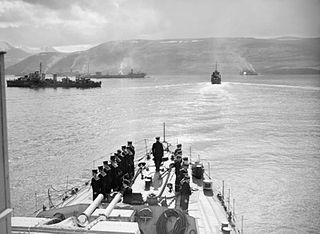
PQ 17 was the code name for an Allied Arctic convoy during the Second World War. On 27 June 1942, the ships sailed from Hvalfjörður, Iceland, for the port of Arkhangelsk in the Soviet Union. The convoy was located by German forces on 1 July, after which it was shadowed continuously and attacked. The First Sea Lord Admiral Dudley Pound, acting on information that German surface units, including the German battleship Tirpitz, were moving to intercept, ordered the covering force built around the Allied battleships HMS Duke of York and the USS Washington away from the convoy and told the convoy to scatter. Because of vacillation by Oberkommando der Wehrmacht, the Tirpitz raid never materialised. The convoy was the first large joint Anglo-American naval operation under British command; in Churchill's view this encouraged a more careful approach to fleet movements.

Operation Pedestal, known in Malta as Il-Konvoj ta' Santa Marija, was a British operation to carry supplies to the island of Malta in August 1942, during the Second World War.

The Arctic convoys of World War II were oceangoing convoys which sailed from the United Kingdom, Iceland, and North America to northern ports in the Soviet Union – primarily Arkhangelsk (Archangel) and Murmansk in Russia. There were 78 convoys between August 1941 and May 1945, sailing via several seas of the Atlantic and Arctic oceans, with periods with no sailings during several months in 1942, and in the summers of 1943 and 1944.
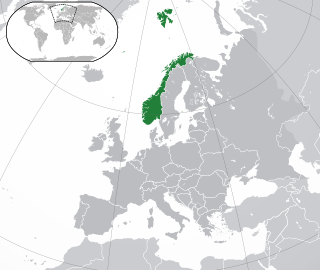
Convoy PQ 16 was an Arctic convoy of British, United States and Allied ships from Iceland to Murmansk and Archangelsk in the Soviet Union during the Second World War. The convoy was the largest yet and was provided with a considerable number of escorts and submarines. QP 12, a return convoy, sailed on the same day

Operation Vigorous was a British operation during the Second World War, to escort supply convoy MW11 from the eastern Mediterranean to Malta, which took place from 11 to 16 June 1942. Vigorous was part of Operation Julius, a simultaneous operation with Operation Harpoon from Gibraltar and supporting operations. Sub-convoy MW11c sailed from Port Said (Egypt) on 11 June, to tempt the Italian battlefleet to sail early, use up fuel and be exposed to submarine and air attack. MW11a and MW11b sailed next day from Haifa, Port Said and Alexandria; one ship was sent back because of defects. Italian and German (Axis) aircraft attacked MW11c on 12 June and a damaged ship was diverted to Tobruk, just east of Gazala. The merchant ships and escorts rendezvoused on 13 June. The British plans were revealed unwittingly to the Axis by the US Military Attaché in Egypt, Colonel Bonner Fellers, who reported to Washington, D.C. in "Black"-coded wireless messages; it was later discovered that the Black Code had been broken by the Servizio Informazioni Militare.
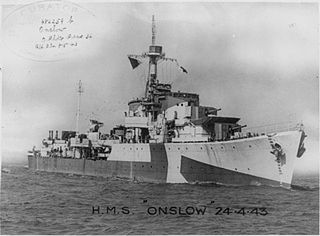
HMS Onslow was an O-class destroyer of the Royal Navy. The O-class were intermediate destroyers, designed before the outbreak of the Second World War to meet likely demands for large number of destroyers. They had a main gun armament of four 4.7 in guns, and had a design speed of 36 kn. Onslow was ordered on 2 October 1939 and was built by John Brown & Company at their Clydebank, Glasgow shipyard, launching on 31 March 1941 and completing on 8 October 1941.

Convoy PQ 18 was an Arctic convoy of forty Allied freighters from Scotland and Iceland to Arkhangelsk in the Soviet Union in the war against Nazi Germany. The convoy departed Loch Ewe, Scotland on 2 September 1942, rendezvoused with more ships and escorts at Iceland and arrived at Arkhangelsk on 21 September. An exceptionally large number of escorts was provided by the Royal Navy in Operation EV, including the first escort carrier to accompany an Arctic convoy. Detailed information on German intentions was provided by the code breakers at Bletchley Park and elsewhere, through Ultra signals decrypts and eavesdropping on Luftwaffe wireless communications.
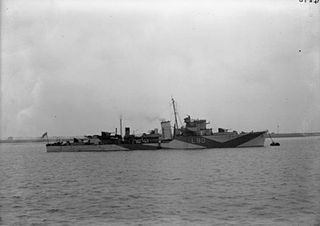
HMS Ledbury was an escort destroyer of the Hunt class Type II. The Royal Navy ordered Ledbury's construction two days after the outbreak of the Second World War and J. I. Thornycroft Ltd laid down her keel at their Southampton yard on 24 January 1940. Air raid damage to the yard delayed her construction and she did not launch until 27 September 1941. Her initial assignment was to perform escort duties between Scapa Flow and Iceland. She remained in this theatre for the first part of the war, during which time she served with the ill-fated Arctic convoy PQ 17 in June 1942, from which twenty-four ships were lost.
MV Atheltemplar was a motor tanker built by Lithgows, Port Glasgow. She was launched on 15 April 1930, registered in Liverpool and operated by the United Molasses Co Ltd of London. She was transferred to Athel Lines on 1 January 1940.

Martin Harlinghausen was a German military aviator and general. Harlinghausen specialised in maritime interdiction and anti-warship operations. During World War II Harlinghausen was the leading exponent of anti-ship warfare with the destruction of 22 ships credited to him.

Kampfgeschwader 26 "Löwengeschwader" was a German air force Luftwaffe bomber wing unit during World War II. Its units participated on all of the fronts in the European Theatre until the end of the war. It operated three of the major German aircraft medium bomber types; the Heinkel He 111, Junkers Ju 88 and the Junkers Ju 188. The unit engaged in both strategic bombing, close air support, anti-shipping and aerial interdiction operations. The majority of its operational life – not entirely unlike another Luftwaffe wing designated KG 40 — was spent on anti-shipping missions.
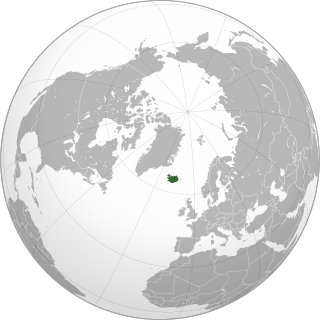
Operation FB took place as part of the Arctic Convoys of the Second World War. The operation consisted of independent sailings by unescorted merchant ships between Iceland and Murmansk. In late 1942, the Allies had taken the offensive against Germany but the dispatch of supplies to the USSR by convoy via the Arctic route was suspended, due to the demands of the Mediterranean campaign. Convoy PQ 19 was cancelled because the Home Fleet diverted ships to the Mediterranean for Operation Torch which would have had to be postponed for three weeks had ships been provided for PQ 19.

Kampfgeschwader 30 was a Luftwaffe bomber wing during World War II.

Convoy PQ 15 was an Arctic convoy sent from Iceland by the Western Allies to aid the Soviet Union during the Second World War. The convoy sailed in late April 1942, reaching the Soviet northern ports after air attacks that sank three ships out of twenty-five.

Convoy PQ 14 was an Arctic convoy sent from Britain by the Western Allies to aid the Soviet Union during the Second World War. Convoys from Britain had been despatched since August 1941 and advantage had been taken of the perpetual darkness of the Arctic winter. German operations against the convoys had been muted due to the need to support Operation Barbarossa, confidence in imminent victory and the small size of the convoys. In late 1941 and early 1942 the Luftwaffe and Kriegsmarine had reinforced Norway with aircraft and ships.

Convoy PQ 8 was an Arctic convoy of the Western Allies to aid the Soviet Union during the Second World War. The convoy left Iceland on 8 January 1942. On 12 January the convoy had to turn south to avoid ice; the weather was calm, visibility was exceptional, with a short period of twilight around noon. and arrived in Murmansk nine days later.

Arctic naval operations of World War II were the World War II naval operations that took place in the Arctic Ocean, and can be considered part of the Battle of the Atlantic and/or of the European Theatre of World War II.

Convoy QP 14 was an Arctic convoy of the QP series which ran during the Second World War. The convoy was a return journey of Allied ships from the port of Archangelsk in the Soviet Union to Loch Ewe in the west of Scotland. The British planned to send Convoy PQ 18 from Iceland to Murmansk and when the convoys crossed transfer much of the escort force from the outbound convoy to Convoy QP 14 and escort back it through the most dangerous waters off Norway.

Operation Orator was the code name for the defence of the Allied Arctic convoy PQ 18 by British and Australian air force units, based temporarily in North-West Russia, against attack by the German battleship Tirpitz and other Kriegsmarine surface vessels. The wing, known as the Search & Strike Force, was commanded by Group Captain Frank Hopps and its maritime strike element was the Leuchars Wing, comprising No. 144 Squadron, Royal Air Force (RAF) and No. 455 Squadron, Royal Australian Air Force (RAAF) equipped with Handley-Page Hampden TB 1 torpedo bombers.















